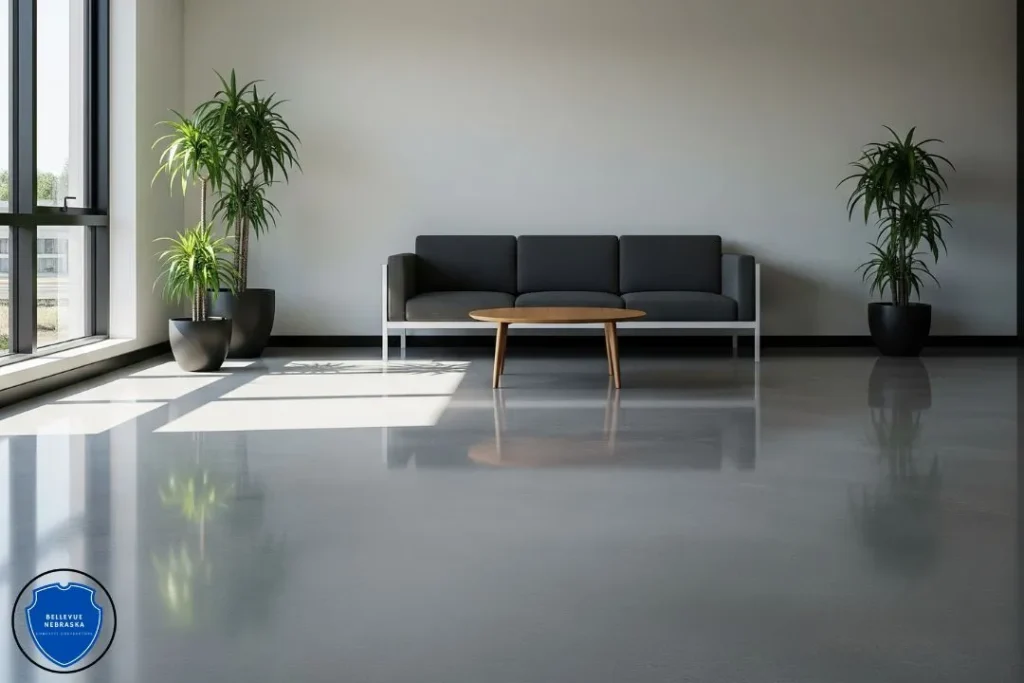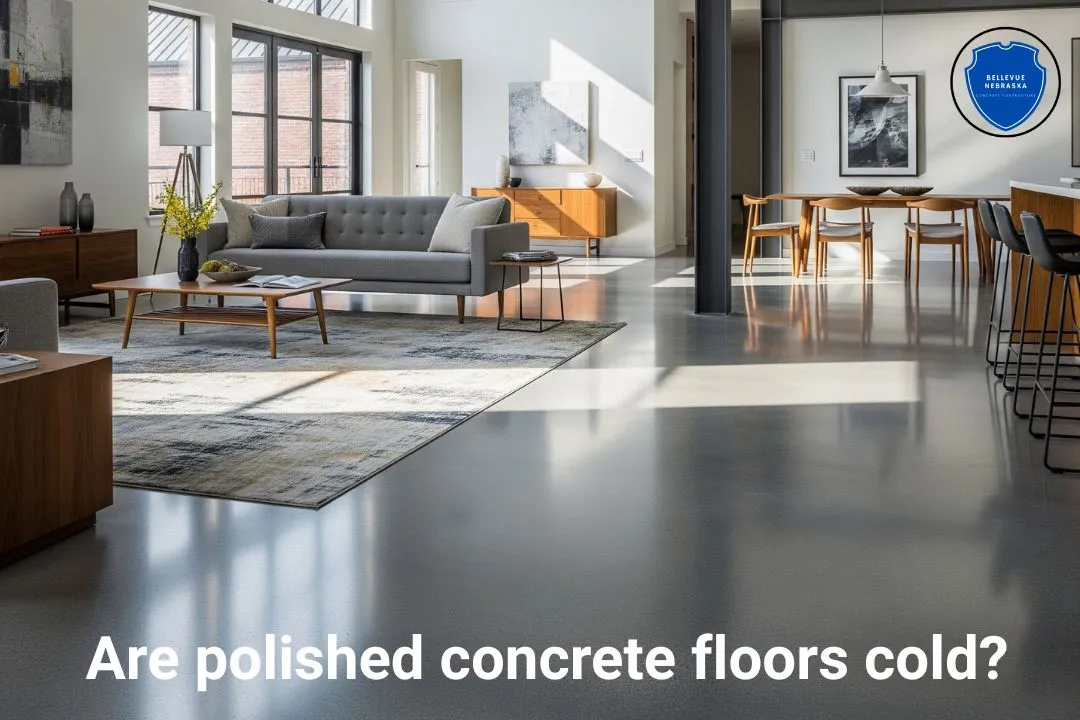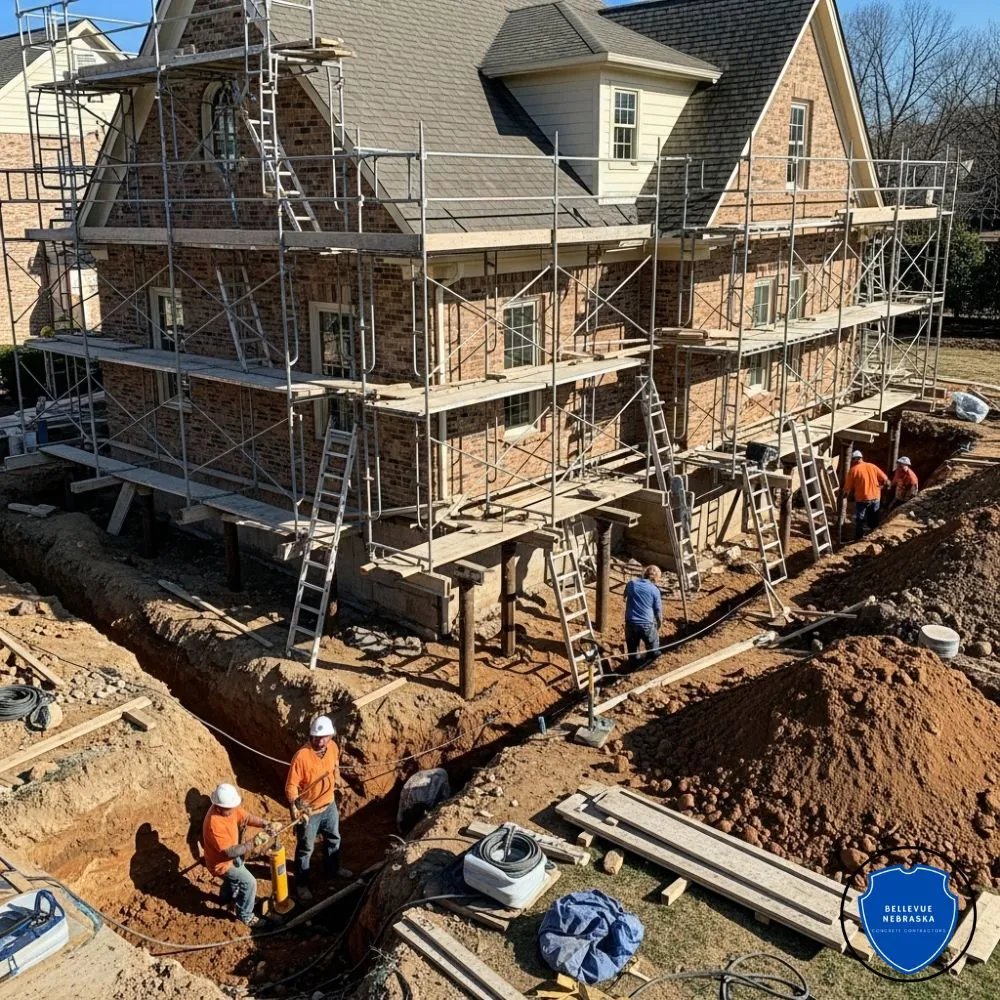Polished concrete floors are often seen as stylish and practical, but some people worry they might feel cold. The truth is, they can feel cool to the touch, but that doesn’t mean they are uncomfortable.
The temperature of a concrete floor in Bellevue, NE, often changes with the seasons. In winter, it can feel cooler due to the region’s cold weather. In summer, it may stay comfortably cool indoors. With the right setup, these floors can stay comfortable throughout the year.
In this blog, you’ll learn how concrete floors feel underfoot and how to make them work well in your space.
What Are Polished Concrete Floors?
Polished concrete floors are made by grinding and smoothing a concrete surface until it becomes shiny and flat. This process removes rough spots and gives the floor a clean, polished finish.
A hardening agent is often applied to make the surface stronger and help it resist stains and scratches. Because the process uses the existing concrete slab, it reduces the need for extra materials, which makes it more eco-friendly and affordable.
Many modern homes and commercial spaces use polished concrete because it looks sleek and lasts a long time. It also fits many styles, from industrial to minimal.
Ideal uses of polished concrete floors:
- Living rooms and open-plan spaces
- Office and retail interiors
- Kitchens and dining areas
- Garages and basements
- Art studios or creative workspaces
- Entryways and high-traffic areas
Are Polished Concrete Floors Naturally Cold?

Concrete is a dense material that absorbs and holds temperature from its surroundings. If the room is cool, the floor will feel cool. In winter or homes with poor insulation, polished concrete may feel colder than surfaces like carpet or vinyl. However, it does not create cold by itself. It simply reflects the temperature around it.
Compared to wood or carpet, concrete does not provide much natural warmth. On the other hand, it does not trap heat like thick rugs or padded floors. The smooth surface can feel cool under bare feet, especially in shaded or north-facing rooms. Still, many people enjoy the fresh, clean feel of polished concrete, especially in warmer months.
The Role of Climate and Location
The way polished concrete feels underfoot depends a lot on where you live and how your indoor space is built. In warm, sunny regions, concrete can absorb heat during the day and stay warm into the evening. Homes with good natural sunlight or floor heating will feel more comfortable, even with bare concrete floors.
In cooler regions, concrete may feel cooler most of the time, especially during long winters. The floor may also take longer to warm up if your space has poor insulation or limited sunlight.
Indoor temperature and seasonal changes also affect comfort. A room with thick curtains, double-glazed windows, and closed doors will stay warmer, making the floor feel less cold. In contrast, open spaces with large windows and drafts may cause the concrete to stay cooler.
Concrete Floors vs. Other Flooring Materials
Some floors feel warmer underfoot than others. The way a material holds or reflects heat affects how it feels throughout the day. Here’s how polished concrete compares:
| Flooring Type | Feels Cold? | Holds Warmth? | Comfort Level | Notes |
| Polished Concrete | Often cool | Yes, absorbs heat | Moderate | Can feel warm with sunlight or floor heat |
| Tiles | Cold | No | Low | Very cold in winter, hard underfoot |
| Hardwood | Mildly warm | Some heat retention | High | Naturally warmer, feels cozy |
| Carpet | Warm | Good insulation | Very high | Softest and warmest option |
| Vinyl | Mildly warm | Low to moderate | High | Warmer than tile, softer surface |
Can Polished Concrete Hold Heat?
Polished concrete has high thermal mass, which means it can absorb heat from sunlight, heaters, or warm air and release it slowly over time. This helps balance the room temperature.
During the day, concrete stores warmth from direct sunlight or underfloor heating. As the air cools in the evening, the floor releases stored heat back into the space. This quality makes concrete efficient in well-insulated homes and buildings with passive solar design.
Although it may feel cool at first, polished concrete can stay comfortably warm with the right setup. Heating systems, rugs, and natural sunlight all enhance this effect and improve comfort.
Tips to Keep Polished Concrete Floors Comfortable Year-Round
With a few simple steps, polished concrete floors can feel cozy in winter and pleasantly cool in summer. These small changes help you enjoy comfort all year:
- Add large rugs in sitting or sleeping areas.
- Use curtains to trap warmth during colder months.
- Let sunlight in during the warmest part of the day.
- Install underfloor heating if budget and space allow.
- Close windows to prevent cold drafts in winter.
- Choose soft furnishings to warm up the space.
- Use warm-colored decor to create a cozy feel.
- Place indoor plants to soften the hard surface.
- Wear slippers or warm socks in colder seasons.
- Insulate rooms properly to reduce floor heat loss.
Final Thoughts
Polished concrete floors can feel cool, but that doesn’t make them uncomfortable or impractical. They reflect the temperature of their environment, so you can control how they feel with the right setup. In Bellevue, NE, decorative concrete is a popular choice for both homes and businesses because of its sleek look and flexibility in design. With good insulation, thoughtful design, and small touches like area rugs or floor heating, these floors stay comfortable through all seasons.
Many homeowners enjoy their clean appearance, low maintenance, and long lifespan. While concrete may not feel as warm as carpet, it can still create a cozy and welcoming space when used with care.
Frequently Asked Questions
How durable are polished concrete floors?
Polished concrete is very durable and can last for decades with proper care.
Are polished concrete floors slippery?
They can be slippery when wet, but adding a non-slip finish or rug can improve traction.
Can polished concrete floors crack over time?
Yes, hairline cracks can develop due to settling or temperature changes, but they are usually minor and part of the natural look.
Will polished concrete raise my home’s value?
It can, especially when done professionally and paired with modern, clean interior design.



